Sep 8, 2020 | Britain, coin covers, coins

Reverse of the £5 Queen Coin
Queen’s frontman and principal writer was Farrokh Bulsara, better known by his stage name Freddie Mercury. Mercury was talented, charismatic, and a showman whose first big hit “Killer Queen” put them on the radar of young rockers in the 1970s.
In 1975, Queen released A Night at the Opera with the iconic “Bohemian Rhapsody” that always appears on the Top 10 lists of all-time songs. A Day at the Races followed, sometimes considered Part 2 to A Night at the Opera. Next was News of the World featuring “We Will Rock You” and “We Are the Champions” that continue to be featured as anthems in sports stadiums.
There is also the phenomenal performance by Queen at the 1985 Live Aid concert at Wembley Stadium.
Earlier this year, the Royal Mint issued the first coin in their “Music Legends” collection to honor Queen. Still featuring his long curly hair, Brian May, help the Royal Mint launch the new coin series.
The coins are available as a half-ounce silver proof and a £5 uncirculated coin with limited edition slipcases. The Royal Mint partnered with the Royal Mail to produce a coin cover.
Coin covers, known as Philatelic Numismatic Covers (PNC), are covers with coins or medals encased and usually postmarked on the First Day of Issue of the stamps. PNCs are popular in Europe. The colorful cache with the stamps and coins gives the collectible more context and appeal.
-

-
Philatelic Numismatic Cover honoring Queen
-
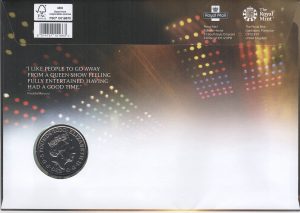
-
Back of the Coin Cover honoring Queen
-

-
Inside the cover is a card that holds the coin.
-

-
Back of the insert Card of the PNC Honoring Queen
My collection contains every coin cover issued by the U.S. Mint, some issued by private companies, and several by the Royal Mint and Royal Mint with global interest topics. When I discovered that they issued a coin cover with the Queen coin, it was an opportunity to add a great collectible to my collection.
The covers are a great way to collect something numismatic that ties to other interests. Aside from classic rock, I noticed that the Royal Mint and Royal Mail has two limited edition covers celebrating Sherlock Holmes. I first read Arthur Conan Doyle’s The Hound of the Baskervilles for a college literature class. I thought it was fantastic. When discussing the book, the professor said that Doyle wrote many short stories featuring Holmes. As a poor college student, I was able to find an affordable two-volume set of Doyle’s 56 short stories in a used bookstore. Later, I read the four Sherlock Holmes novels.
As you can see, the coin covers add additional context to the collection. It bridges numismatics with other subjects that allow the enjoyment of both. In fact, I was listening to the Top 700 countdown of the 1970s hits on SiriusXM’s 70s on 7 channel that reminded me to write about the cover.
For the record, the listeners of the 70s on 7 voted Queen’s “Bohemian Rhapsody” as the Number 1 song of the 1970s. “We Will Rock You/We Are The Champions” was Number 10.
Apr 7, 2011 | coin covers, commentary, US Mint
In May 1977, Bert Lance was the Director of the Office of Management and Budget under President Jimmy Carter. He was interviewed for Nation’s Business, the news letter for the U.S. Chamber of Commerce. Lance was quoted in the article saying:
Bert Lance believes he can save Uncle Sam billions if he can get the government to adopt a simple motto: “If it ain’t broke, don’t fix it.” He explains: “That’s the trouble with government: Fixing things that aren’t broken and not fixing things that are broken.”
Someone forgot to remind the U.S. Mint of Lance’s axiom.
Last month, the U.S. Mint announced the availability of the availability of 2011 Andrew Johnson $1. I am a fan of the coin covers. I have the covers from the 50 State Quarters, D.C. & Territories, Westward Journey Nickels, and the 2000 Sacagawea Dollar covers. I also own the four covers produced by the U.S. Mint produced in the years leading to the American Revolution Bicentennial. However, I was reminded of Bert Lance when I saw the new cover.
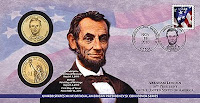 Starting in 2007, the covers had a large image of the president being honored with the president’s name, term, and a postmarked current stamp. On the reverse is a short blurb about the president. Embedded in the cover are two uncirculated coins, one from Philadelphia and the other from Denver, from the first day the coins were struck. It is the only way to know on which date the coins were struck. The entire cover was beautiful in its simplicity.
Starting in 2007, the covers had a large image of the president being honored with the president’s name, term, and a postmarked current stamp. On the reverse is a short blurb about the president. Embedded in the cover are two uncirculated coins, one from Philadelphia and the other from Denver, from the first day the coins were struck. It is the only way to know on which date the coins were struck. The entire cover was beautiful in its simplicity.
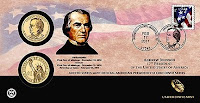 In trying to deal with its new branding, the U.S. Mint altered the cover that reduced the cover and added a black bar across the bottom of the cover. The black bar is empty except for a small version of the official U.S. Mint logo on the left and the new branding logo on the right. As a result, the portrait of the president is made smaller. The space taken up by that garish black bar causes the rest of the cover to look cluttered.
In trying to deal with its new branding, the U.S. Mint altered the cover that reduced the cover and added a black bar across the bottom of the cover. The black bar is empty except for a small version of the official U.S. Mint logo on the left and the new branding logo on the right. As a result, the portrait of the president is made smaller. The space taken up by that garish black bar causes the rest of the cover to look cluttered.
Rather than trying to find a more subtle way to add their branding to the cover, like on the reverse without the tacky black bar, the U.S. Mint broke one of their better presentations.
After this debacle, maybe the CCAC Blueprint Report should have added packaging design to the list of functions that should be reviewed!
Images courtesy of the U.S. Mint
Mar 4, 2011 | coin covers, coins, currency
Let’s do something different. Let’s talk collecting!
I am finding quite a few 2011 coins in pocket change. Most of my finds are Lincoln cents, but there have been a few 2011-P nickels mixed in. For the first time, I found 2010 dimes in change. I have yet to find any America the Beautiful Quarters® in change. Finding 2011 coins in pocket change this early is a good sign, until oil prices rise and put us back into the “Big Recession.”
In recent years, I have purchased the $2 Single Note Collection from the Bureau of Engraving and Printing. I don’t collect the notes from all of the Federal Reserve branches, I only collect the ones from the Federal Reserve Bank New York. The $2 Single Note Collection features a Series 2003A Federal Reserve note with a a serial number beginning with “2010xxxxD” in a special holder. During the pre-release period, the BEP will only sell the 2011 $2 Single Note Collection as a set. They will begin to sell the individual notes on March 15.
Last week, I purchased the 2010 Presidential $1 Coin Covers. I have been buying U.S. Mint coin covers since they were first released in 1999 for the 50 State Quarters. I find these very cool collectibles and have enjoyed showing them off. They are not popular with collectors and do not sell well in the secondary market, but I like them. To store and display them, I use a two pocket first day cover page stored in a loose leaf binder with anticorrosion pages in the front and back of the book.
I did not buy the 2010 annual sets. The proof sets contain 14 coins and the mint set has 28 coins. Because of the number of coins, the prices for these sets are high. I am not sure it is worth the price since since I collect uncirculated and proof coins in various blue albums and feel that these sets are redundant collectibles. Up until now, I was collecting mint and proof sets dating back to my birth year. But I am not sure I want to continue. I may stop collecting these sets and sell off the collection except for my birth year and the 1965-67 Special Mint Sets.
In fact, I was looking at my collection and may sell a lot of it to just concentrate on my date-mintmark collection, U.S. Mint First Day Covers, interesting world Philatelic-Numismatic Covers (PNC), and some other smaller specialized collections. The rest may end up on eBay!
Speaking of Maryland Colonial currency, I have seen buyer-friendly prices on different auction websites. I wonder if the lack of activity is because of the economy or general interest. For collectors, this is good since we can buy what we want at a good price with a potential for a good future return.
Aug 16, 2008 | coin covers, errors
An interesting part of coin collecting is to find a different niche that adds more to the collection than just the coin. I started with coin covers when the US Mint introduced them for various coins, including the 50 State Quarters series. Then I found that coin covers are popular in Europe, specifically in Great Britain and Australia where they refer to these collectibles as philatelic numismatic covers (PNC), to distinguish them from others like first day covers (FDC).
 Recently, I was searching for PNCs on that famous online auction website when I came across an interesting cover. It was postmarked in 1972 and included a coin with an off-center strike. I did not know much about the cover but purchased it anyway because it had that “oh neat” quality.
Recently, I was searching for PNCs on that famous online auction website when I came across an interesting cover. It was postmarked in 1972 and included a coin with an off-center strike. I did not know much about the cover but purchased it anyway because it had that “oh neat” quality.
When I received the cover, I examined it closely. It appears to be a souvenir from the Error-A-Rama Error Coin Convention held in 1974 at the El Cortez Hotel in San Diego. The convention is sponsored by the Numismatic Error Collectors of America, one of the two clubs that were merged to form today’s Combined Organizations of Numismatic Error Collectors of America (CONECA). The stamp was the common 8-cent stamp for the day and the postmark was made on the first day of the convention.
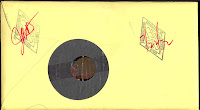 The coin is a Lincoln Cent that was struck 90-percent off center. The coin is held in place by a piece of cellophane tape on the reverse wit the entire inner card being wrapped in plastic. The envelope is sealed with the logo of the San Diego club and initials on the flap.
The coin is a Lincoln Cent that was struck 90-percent off center. The coin is held in place by a piece of cellophane tape on the reverse wit the entire inner card being wrapped in plastic. The envelope is sealed with the logo of the San Diego club and initials on the flap.
To find out more information, I wrote to several error experts sending images of the cover. I received a response from noted error expert and dealer Fred Weinberg. Weinberg said that the initials on the back of the cover are of Jim Heine, one of the organizer’s of the San Diego error club—one of three Southern California error clubs of the late 1960s through the mid 1970s.
“Covers like this were signed to both ‘authenticate’ the item,” Weinberg wrote, “and to show that the envelope hadn’t been opened or tampered with.”
Weinberg reports that these covers were issued for the Error-A-Rama shows in the 1970s. While there are no records of the number of covers made, Weinberg estimates that “at least 100-200 or so covers were made up” He also said that Heine also sold his own series of error covers with different error coins.
Aside being an interesting collectible, it is wonderful to be part of a hobby where you can email a leading expert for more information. I met Fred Weinberg at the World’s Fair of Money in Baltimore and thanked him in person. But I would like to repeat my appreciation here: THANK YOU, FRED!
Apr 16, 2007 | coin covers, dollar, grading, US Mint
In a previous entry, I wrote that Numismatic Guarantee Corporation (NGC) would certify US Mint American Presidency $1 Coin Cover Series holders with the designation of “First Day of Mintage.” Like many, I assumed that NGC would remove the coins from the cover and put them into their standard slab. But NGC surprised us and announced a different program that gives the submitter the choice of encasing the coins in the standard NGC holders or have the entire cover sealed in a clear, semi-rigid plastic sleeve. NGC notes that this “allows the U.S. Mint packaging to be preserved while receiving the advantages of an NGC certified grade.”
 The holder is reminiscent of the holders that are used by their sister company Paper Money Guarantee (PMG) where the cover will be encased in the sleeve with the label on top. The NGC label will include the year and mint mark of the coins, the name of the president it honors, and the designation “First Day of Mintage.” If the coins do not have the same grade, the grades will be listed separately.
The holder is reminiscent of the holders that are used by their sister company Paper Money Guarantee (PMG) where the cover will be encased in the sleeve with the label on top. The NGC label will include the year and mint mark of the coins, the name of the president it honors, and the designation “First Day of Mintage.” If the coins do not have the same grade, the grades will be listed separately.
 In order to receive the “First Day of Mintage” designation, NGC recommends that the covers be submitted in the Mint wrapping still attached to the cardboard. NGC will not encase damaged or covers that appear to be tampered. NGC will only do this for covers produced by the US Mint. NGC will charge their standard rates for each coin. All minimums, insurance, and shipping fees apply.
In order to receive the “First Day of Mintage” designation, NGC recommends that the covers be submitted in the Mint wrapping still attached to the cardboard. NGC will not encase damaged or covers that appear to be tampered. NGC will only do this for covers produced by the US Mint. NGC will charge their standard rates for each coin. All minimums, insurance, and shipping fees apply.
Considering that the Mint’s covers do not have any text written inside the envelope or under the flap, the is a very good idea by NGC. The collector can have the experience of the collectible while allowing the coins to be graded by NGC. I probably will not avail myself of this service, but it is one of the better ideas a third-party grading service has had to extend their brand.
Images are from NGC.
Clicking on the image will show the enlarged version.
Apr 15, 2007 | coin covers, coins, gold, medals, policy, US Mint
I was very surprised to learn that the George Washington First Day Covers were sold out at the US Mint. There have been very few sellouts for the 50 State Quarters™ First Day Covers and others, like the Westward Journey Nickel™ First Day Covers, went off sale after the legal sales date expired. I wonder if this is a “first issue” or it will continue for all presidents? Maybe it will only be for popular presidents where Abraham Lincoln would sell out but not Millard Fillmore?
There has been talk of creating fractional American Buffalo 24-Karat Gold Coins but no indication from the Mint that this will happen. The Mint is offering uncirculated American Silver Eagle coins with the “W” mint mark on a subscription basis. I wonder if the expanded product line is too much for the Mint to handle the additional Buffalo gold coins and whether they are trying to protect the American Eagle gold program?
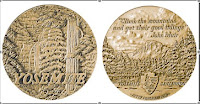 Although I am not a collector of medals, I am amazed at the artwork on the medals produced by the US Mint. While looking at the Mint’s online catalog, I found the new Yosemite Nation Park Centennial Bronze Medal and was just captivated by its design. It seems to capture the grander and beauty of Yosemite. Other medals are just phenomenal in their design. These medals are struck on 90-percent copper and 10-percent zinc blanks in Philadelphia. It may be worth looking into.
Although I am not a collector of medals, I am amazed at the artwork on the medals produced by the US Mint. While looking at the Mint’s online catalog, I found the new Yosemite Nation Park Centennial Bronze Medal and was just captivated by its design. It seems to capture the grander and beauty of Yosemite. Other medals are just phenomenal in their design. These medals are struck on 90-percent copper and 10-percent zinc blanks in Philadelphia. It may be worth looking into.
On December 14, 2006, the Mint announced a ban on the melting and limited the export of cents and nickels for 120 days (4 months). That period was up on Saturday, April 14, 2007 with no further statement from the Mint. Rumor has it that the Mint will issue a statement continuing the melting ban, raise the individual traveler’s limit from $5 to $25 and the numismatic shipments from $100 to $250. It is speculated that this will be a six month extension of the melting ban.
I would like to end with a non-numismatic review. Last night, my wife and I saw the performance of Titus Andronicus by the Shakespeare Theatre Company of Washington, DC. Titus Andronicus is Shakespeare’s most violent plays depicting the revenge strategies and violence of ancient Rome. It is a powerful play about the misplaced sense of honor some have to authority and tradition and how revenge based on that honor can feed upon itself to the detriment of everyone. It is an interesting commentary on today’s society regardless of your political persuasion. Director Gale Edwards did a fantastic job of bringing this play to the stage with great visuals and heart-pumping music. If you live, work, or visit Washington, DC during its run (until May 20), I highly recommend this play.
Image courtesy of the United States Mint.
Apr 12, 2007 | coin covers, dollar, grading, US Mint
Numismatic Guarantee Corporation (NGC) announced today that they will recognize the Presidential Dollar coins submitted for grading still in US Mint Official American Presidency $1 Coin Cover Series holders as “First Day of Mintage.” NGC said that there will be no date sensitivity requirements but the coins will have to be submitted in the Mint’s shrink wrap for the coins to be eligible for the designation.
NGC will post additional detail to their website on Monday, April 16. Stay tuned.
Mar 30, 2007 | coin covers, coins, dollar, US Mint
When it comes to modern collectibles, I am into the “oh, neat!” of collectibles. I collect American Silver Eagles, silver Chinese Pandas, and British Britannias because they are neat! One neat collectible I discovered are First Day Coin Covers sold by the US Mint.
For those who do not collect philatelic items, First Day Covers are envelopes with stamps that are canceled on the first day of issue. Coin covers, also called Philatelic Numismatic Covers (PNC), are covers with coins or medals encased and usually postmarked on the first day of issue of the numismatic item. I have come to learn that PNCs are popular in Europe. The Royal Mint and Royal Mail partner to create wonder PNC collectibles in the United Kingdom.
The Mint has participated in the production of PNCs in the past but did not produce their own products until the 50 State Quarters program. Since 1999, the Mint as produced covers for all special circulated issues including the 50 State Quarters, Sacagawea Dollar, and the Westward Journey nickels. I have collected these covers from the beginning.
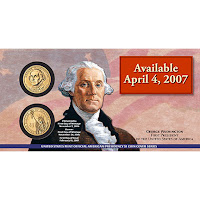 I was perusing the Mint’s online catalog to see what products are on the horizon. There, I found that the Mint will be issuing The American Presidency $1 Coin Cover Series. These covers will feature uncirculated Presidential Dollars from the Denver and Philadelphia mints from the first day of manufacturing. The coins will be attached to an envelope that will include a portrait of the President being honored and a paragraph describing his term of office. The envelope will have the prevailing stamp of the day and will be postmarked on the first day of issue in the president’s hometown. The Mint limits the production to 50,000 covers and cost $14.95—a bargain compared with similar offerings from other sources.
I was perusing the Mint’s online catalog to see what products are on the horizon. There, I found that the Mint will be issuing The American Presidency $1 Coin Cover Series. These covers will feature uncirculated Presidential Dollars from the Denver and Philadelphia mints from the first day of manufacturing. The coins will be attached to an envelope that will include a portrait of the President being honored and a paragraph describing his term of office. The envelope will have the prevailing stamp of the day and will be postmarked on the first day of issue in the president’s hometown. The Mint limits the production to 50,000 covers and cost $14.95—a bargain compared with similar offerings from other sources.
As opposed to the First Strikes or Early Releases coins designated by the third-party grading services, the coins included on the cover are from the first day of production for the coins. This makes them true first day of issue coins as guaranteed by the US Mint. This will be another interesting way to collect the new Presidential Dollar coins. I am looking forward to seeing these covers!
Image from the US Mint.













